A memorandum of understanding is a letter of intent. A MOU is not a legally binding contract, though people often consider the document official. The document precedes the formal legal contract and, of course, is binding.
However, the MOU is often used both in international and multinational agreements. The reason is that the memorandum is easy to create. In addition, unlike the treaties, keeping the documents secret is also easier.
You can also use the simple memorandum of understanding template to help you modify the formal contract if any changes are needed.
Though the documents often come in different complexions and lengths, they have common functions. They are the representations of the expectations made by both parties that agree. Unlike treaties, the memorandum of understanding doesn’t require any funding exchange.
Memorandum of Understanding
When discussing the two parties that want to agree, the memorandum of understanding or MOU always comes first. Though the MoU is typically a non-binding agreement, it should be set before a formal contract is made.
What Should Be There in the MOU Template?
When creating a memorandum of understanding agreement template, there are some key factors that you have to consider carefully.
- Overall Intent
Every MOU template should start with the overall intent outline. It should be the one that shows a clear reflection of purpose from those who get involved in the agreement. You need to make sure that there is no grey area when creating the overall intent.
- Parties Involved
Since the memorandum involves two or more parties, it will be very important to ensure that the template includes the names of all the parties. It can be in the form of individual names, organizations, companies, groups, or others.
- Time Period
Another thing to consider in a template for MOU is the time period. Ensure you mention the exact time period to show when the agreement was made. Remember that the template should contain both the collaboration agreement document’s start date and end date.
- Responsibilities
The responsibilities and duties of the participants should be clearly stated. The information should also be very detailed to ensure future clarity.
Understanding MOU and Official Contracts
Let’s talk about two types of papers people use when they want to work together: the MOU and official contracts.
MOU Before Official Contracts
Think of an MOU as a promise between friends. After the MOU, people can make an official contract, like a set of strict rules they must follow.
MOU vs. Treaties
An MOU is like a handshake on paper between two groups or people. But a treaty is like a big promise between countries. If countries break their treaty promise, it’s a big problem. MOUs are simpler and are more like friendly promises.
Making an MOU is Easier
Creating an MOU is like writing a simple note to a friend. It’s short and easy. But making an official contract is like writing detailed instructions for a game.
MOUs Keep Secrets Better
- A cool thing about MOUs is they can keep secrets well. Since they’re like friendly notes, people only show them to some. But official contracts might have to be shown to many people, especially if it’s a big deal.
The Important Job of MOUs
When people or groups want to work together, they often start with a special promise called an MOU.
MOUs: The First Step Before Official Rules
Think of an MOU like a handshake before a big game. Before two teams play, they might shake hands to show they’re ready to play fair. An MOU is like this handshake. The paper says, “We agree on these main points.” It’s a starting point. After the MOU, the teams can create an official set of rules called a contract. This contract is like the detailed game rules everyone must follow.
Why MOUs Set the Mood for the Big Game
- MOUs are super important because they set the mood for what comes next. When two groups make an MOU, they say, “We trust each other to keep these promises.” This trust helps when it’s time to make the official rules. Everyone knows what to expect because they’ve already made a friendly promise with the MOU.
Understanding the Key Parts of an MOU Template
When people or groups decide to work together, they often start with a special promise on paper called an MOU (Memorandum of Understanding). An MOU has key parts. Let’s talk about these important parts.
Overall Intent: The Main Idea
Every MOU starts with the big idea or main goal.
- Clear Purpose: It’s important to be clear about the main idea. Just like in a game, everyone should know the main goal.
- Avoiding Confusion: We want everyone to be clear and confident. So, it’s good to avoid tricky words or “grey areas” that might make people scratch their heads.
Parties Involved: Who’s Making the Promise?
Like in a team game, we need to know who’s playing. In an MOU, we list out all the players.
- Listing Everyone: We need to write down the names of everyone involved, whether it’s people, groups, or companies.
- Why It’s Important: Knowing who’s in the promise helps everyone understand who’s responsible for what.
Time Period: When Does the Promise Start and End?
Every promise has a start and an end, just like a race. We need to know when to begin and when to finish.
- Clear Dates: It’s good to mark the calendar with start and end dates. This way, everyone knows how long the promise lasts.
- Why Dates Matter: Dates help everyone stay on track. It’s like knowing how many laps to run in a race.
Responsibilities and Duties: What’s Everyone’s Job?
In a team game, every player has a role. The same goes for an MOU.
- Detailing Jobs: We need to write down what each person or group has to do. It’s like giving each player a position in the game.
- Being Clear: It’s important to be clear about everyone’s job. This way, there’s no confusion, and the game runs smoothly.
Why MOUs are Vital in Business and Diplomacy
Let’s learn why these documents are vital in business and diplomacy.
MOU’s Psychological Impact
When two parties shake hands, there’s an unspoken trust formed. An MOU is like a handshake on paper.
- Trust Building: Even before the real work begins, an MOU helps build trust.
- Commitment Showcase: By creating an MOU, both parties show they are committed to the cause, even if it’s just the beginning.
MOUs and Smooth Negotiations
Before a detailed contract, an MOU sets the base.
- Setting Expectations: An MOU helps everyone know what to expect next. It’s like a movie trailer before the full film.
- Avoiding Hurdles: The detailed contract stage often becomes smoother with the main points already agreed upon in the MOU. It’s like having a map during a treasure hunt.
MOUs in Action
MOUs aren’t just papers; they have played big roles in real-world scenarios.
- Business Mergers: Before two companies become one, they often have an MOU.
- Peace Talks: In international relations, an MOU might be made first before two countries sign a peace treaty.
- Environmental Cooperation Agreement: Countries might use MOUs to promise to protect the environment together, even before making detailed plans.
When Should We Use a Promise Paper (MOU)?
An MOU is like a promise on paper between friends or groups. But when is it good to use one? And when should we pick something else?
Good Times to Use a Promise Paper (MOU)
- Starting a New Teamwork: When two groups think about working together, a promising paper is a good first step.
- Who Does What?: If many friends work together, this paper can say who does which job.
- Working with Friends from Far Away: A promise paper is a friendly start if we’re teaming up with friends from another country.
- Changing Plans is Okay: If both groups think plans might change, a promise paper is good because it’s flexible.
- Building Trust: It’s like shaking hands on paper. It shows both sides trust each other.
Not the Best Times for a Promise Paper
- Super Serious Promises: If the promise must be very, very strong, then we need a stricter paper, not just an MOU.
- When Money is Involved: If friends are sharing money, they need a detailed rule paper.
- Big Deals like Houses: Buying or renting homes needs a special paper with strict rules.
- Very Long Promises: If the promise lasts many years, we might need a different kind of paper.
- Big, Important Deals: A promise paper might be too simple for very important jobs with big risks.
Guide to Crafting a MOU Template
Writing a MOU helps everyone know their part and what to expect. Here are some steps:
Title and Introduction
- Start with a Clear Title: Name your document “Memorandum of Understanding” or “MOU.”
- Introduce the Purpose: Write a few sentences on why you’re making this promise paper.
List the Parties Involved
- Name Everyone: Just like a team list, write down the names of all groups or people involved.
State the Main Idea (Overall Intent)
- Explain the Goal: What’s the big reason for this MOU? Clearly describe the main idea or goal everyone is aiming for.
Define the Responsibilities
- Who Does What?: Describe each party’s job or role. It’s like saying who’s the goalkeeper and the striker in a soccer game.
Set the Time Frame
- Start and End Dates: Mention when this promise starts and when it ends. It’s like setting the game time, from start whistle to finish.
Keep the Language Simple
- Use Easy Words: Write in a way that everyone can understand. Avoid big words or jargon.
Mention Any Resources or Tools
- List Needed Items: If the teamwork needs any tools, money, or other resources, list them out.
Talk About Changes (Amendments)
- Changing the Plan: Explain how changes to the MOU can be made. It’s like discussing how to change game strategies if needed.
End with Signatures
- Seal the Promise: At the end, have a space for everyone to sign. It’s like shaking hands to say, “We agree!”
Review and Edit
- Double-check everything: Read the MOU template again. Make sure everything is clear, and everything is correct.
- Ask for Feedback: Before finalizing, ask some people to read it. They might have helpful suggestions.
Benefits of a memorandum of understanding
It’s not a strict rule but a way to say, “Let’s work together!” So, why use one? Here are some of the benefits of using an MOU.
Building Trust
- An MOU is like a friendship note. It helps build trust between groups or friends because it shows everyone is serious about working together.
Flexibility
- MOUs are more relaxed than other papers, like contracts. It means it’s easier to change things if needed. It’s like playing a game with friendly rules.
Quick and Easy
- Making an MOU is faster than creating a detailed contract. It’s like writing a short note instead of a long letter.
Setting the Stage
- An MOU is a great starting point. It helps everyone understand the main ideas before diving into details. It’s like drawing a rough sketch before a full painting.
Avoiding Misunderstandings
- By writing down the main points, everyone knows what to expect. It helps avoid surprises and mix-ups later on.
Great for Teamwork
- When groups want to work on something together, like a project, an MOU helps everyone know their part. It’s like giving everyone a role in a play.
Low Pressure
- Because it’s not a strict rule paper, an MOU feels friendly. It doesn’t put too much pressure on anyone, making agreeing easier.
Tips and Practices for Creating an Effective MOU
So, how do you craft an MOU that communicates intent and builds trust? Here are some essential tips and practices:
Speak Clearly: The Power of Simple Language
- Why It Matters: Just like when talking to a friend, it’s important to be clear. The same goes for MOUs. Using simple, straightforward language makes sure everyone understands the promise being made.
- Tip: Avoid jargon or big words. If you can say it, do so. Everyone should be on the same page from the start.
Team Review: Making Sure Everyone Agrees
- The Process: After writing the MOU, it’s like having a team huddle. Everyone involved should read the MOU and talk about it. This way, if someone is unsure or disagrees with something, it can be fixed before moving forward.
- Why It’s Important: An MOU is a team promise. If one team member doesn’t agree, the promise can break. Making sure everyone is happy with the MOU from the start helps prevent problems later.
Getting Expert Eyes: The Role of Legal Counsel
- What They Do: Legal experts, or lawyers, are like coaches for making promises on paper. They know all the rules and can help ensure the MOU is fair and clear.
- Why It’s Helpful: Even though an MOU isn’t a strict rulebook like a contract, having a lawyer look at it is smart. They can spot any issues or suggest changes to make things clearer. It’s like having a coach give tips before a big game.
Simple memorandum of understanding template
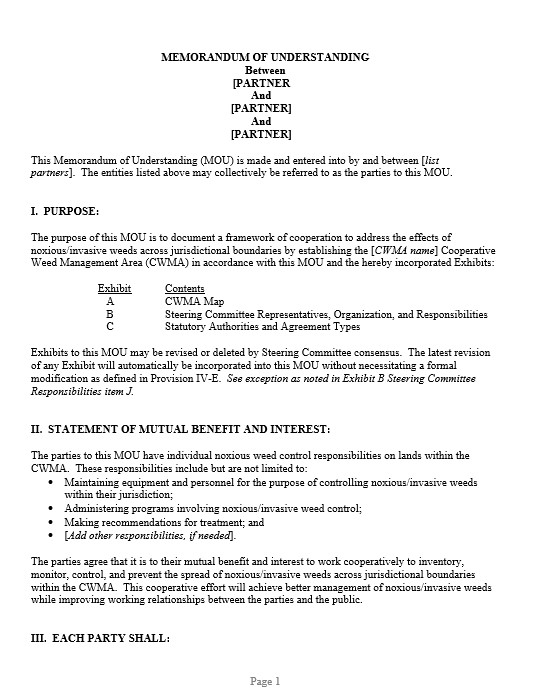
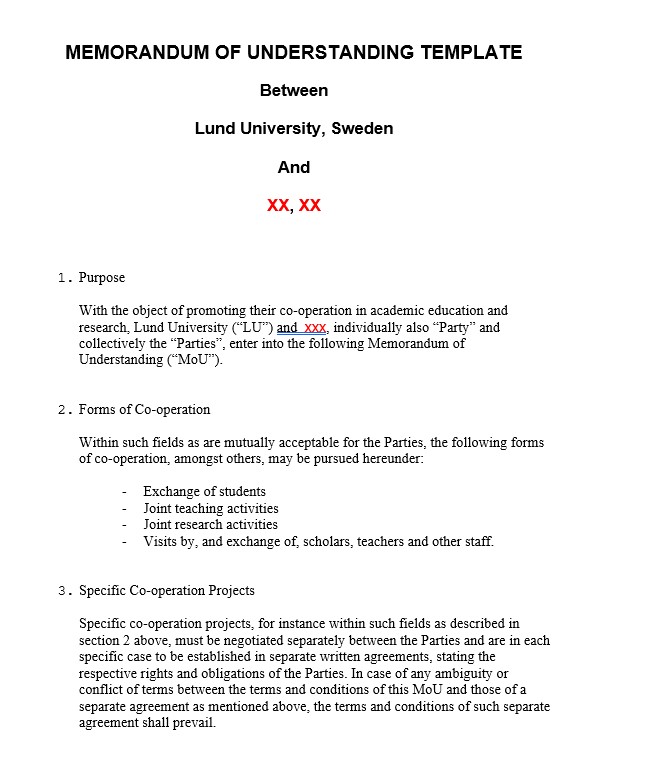
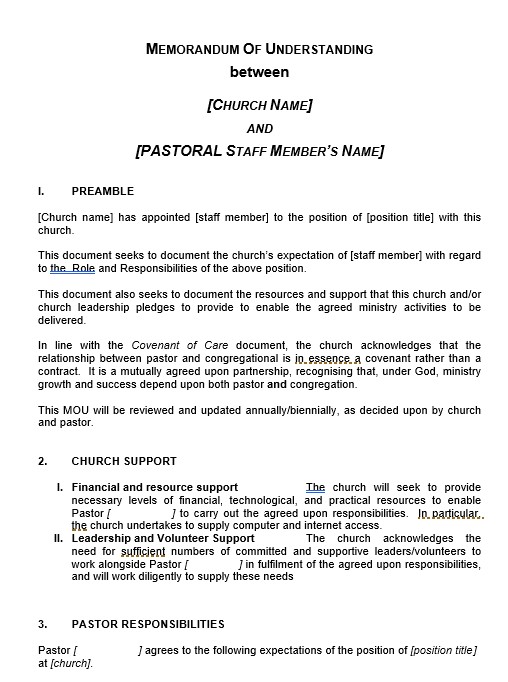
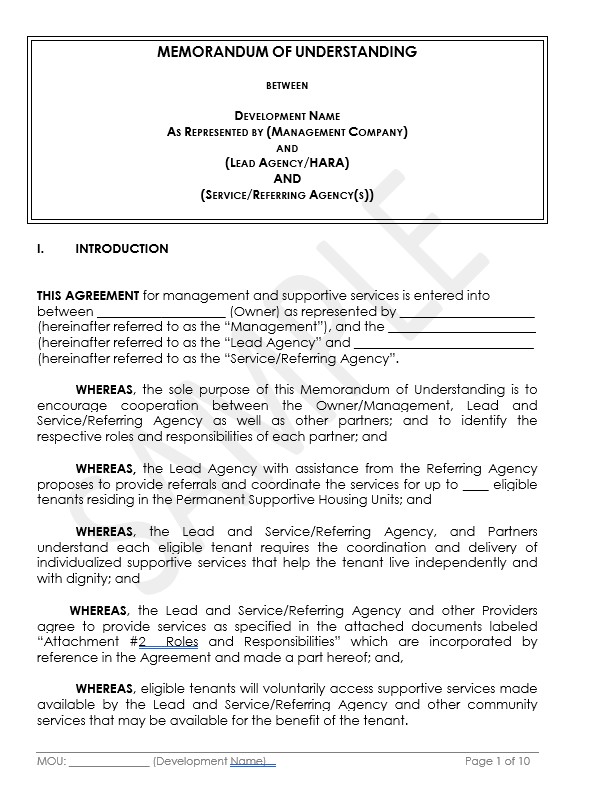
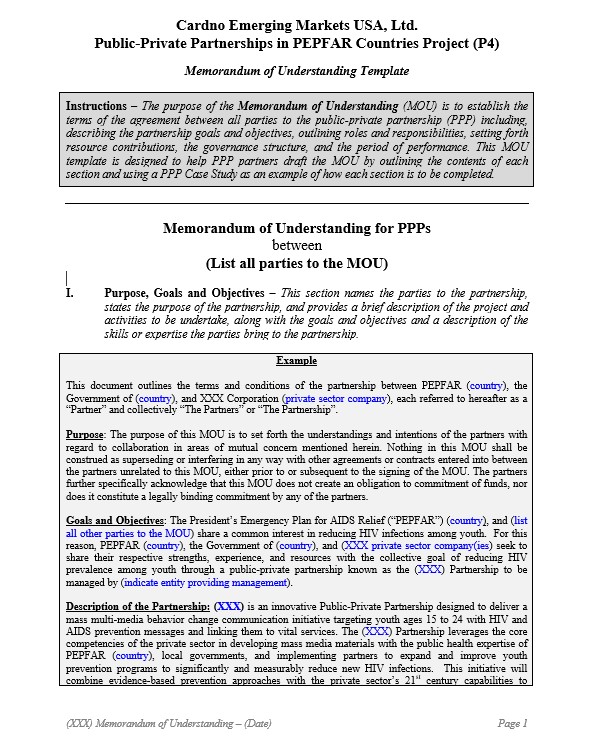
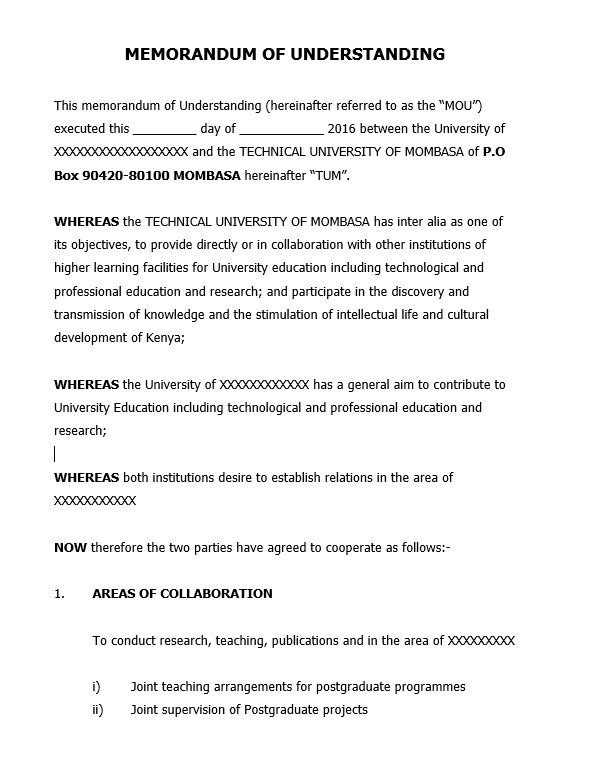
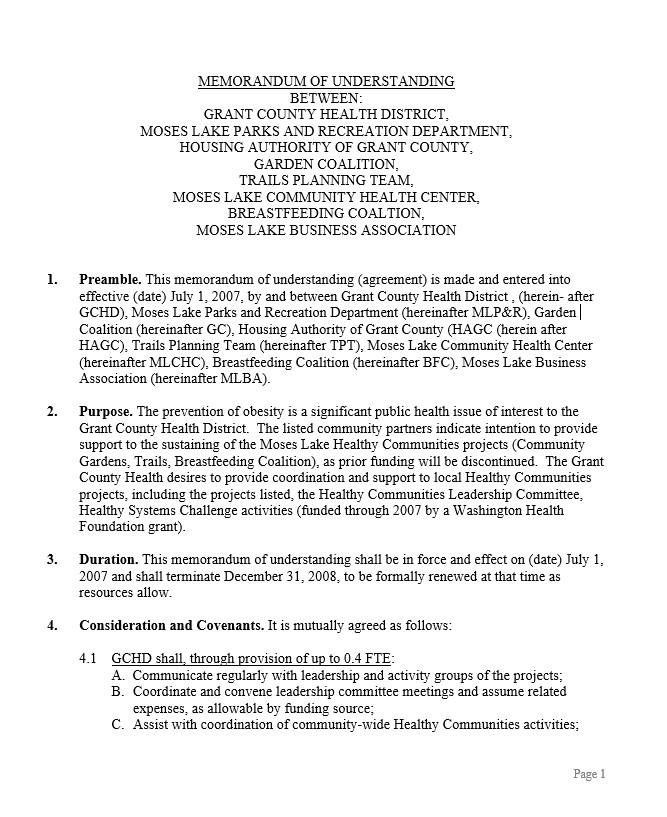
Sample memorandum of understanding template
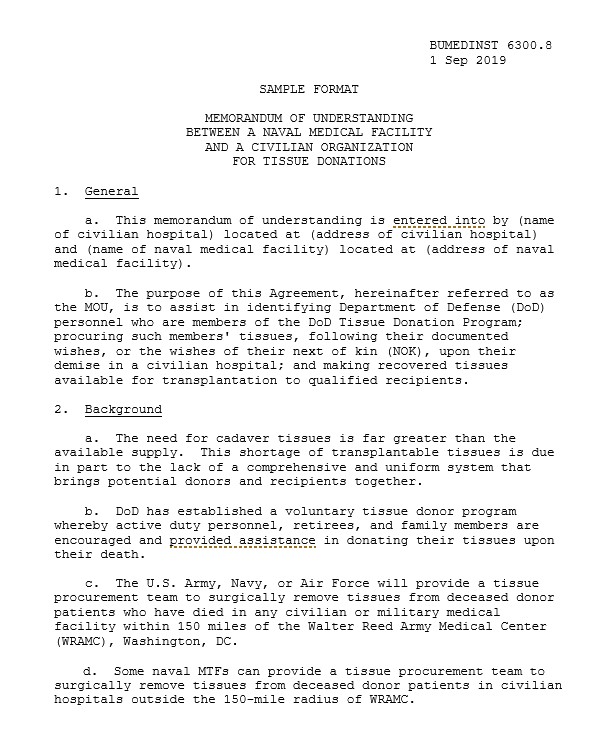
MOUs are like special friendship notes. They help friends and teams say, “Let’s work together and make something awesome!” These notes ensure everyone knows what to do, like in a team game. It’s not just any note, but a big pinky promise on paper.
FAQs
What is a Memorandum of Understanding (MOU) template?
- An MOU template is like a blank form or outline for a promise paper. It helps groups or people easily write down their plans to work together.
Is an MOU legally binding?
- Usually, no. An MOU is more like a handshake on paper. It’s a friendly promise, not a strict rule. But reading it carefully and understanding what it says is always good.
Why use an MOU template?
- It’s a quick start! With a template, you don’t have to start from scratch. It has the main parts ready, and you fill in the details.
Can I customize the MOU template?
- Absolutely! The template is like a guide. You can add, remove, or change parts to fit your needs.
Do I need a lawyer to help with the MOU?
- While MOUs are friendly notes, it’s sometimes good to have an expert, like a lawyer, look at it. They can advise to make sure everyone is clear and happy.
How long should an MOU last?
- It depends on the plan. Some MOUs are for short projects, while others might be for longer a partnership outline. Always check the dates in the MOU.
What if someone needs to follow the MOU?
- Since it’s not a strict rule paper, it’s more about talking and understanding document. If there’s a problem, it’s good to chat and try to fix things together.
Can we turn an MOU into a more official paper later?
- Yes! Many groups start with an MOU and then make a detailed contract later on. The MOU helps set the stage for the next steps.

The content creator team at calipsotree.com is dedicated to making topics accessible to everyone, with over 9 years of experience in writing and breaking down complex concepts into easy-to-understand articles that answer readers’ financial questions.








